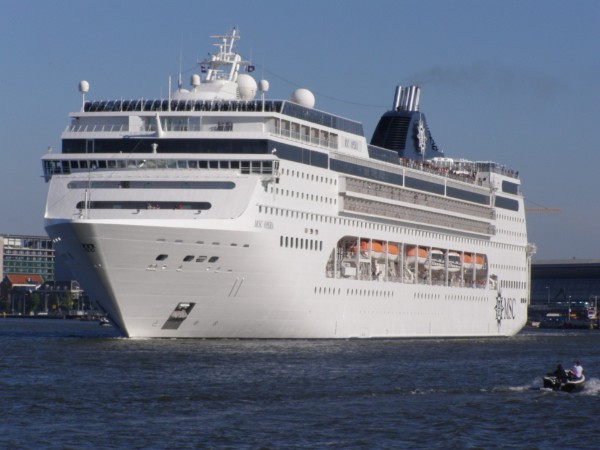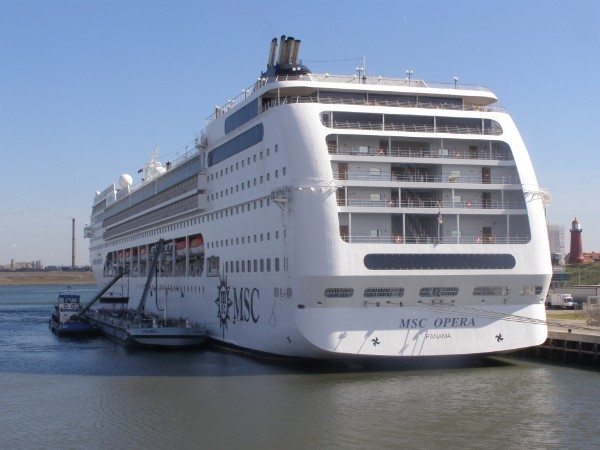MSC Opera
Below, MSC Opera sails out of Amsterdam on the 2nd of june 2010. She is one of the two ships that were built for MSC Cruises. Originally, the two MSC ships were options for Festival Cruises' new class of ships, starting with European Vision in the year 2001.

The first ship of this class for Festival Cruises was the European Vision and this name indicated a new naming strategy for the company, their next vessel was to be named European Dream. On the 1st of december 2000, the European Vision floated out of her building dock. Her sistership European Dream had floated out at the 24th of march 2001. For some reasons, the ship was renamed before her delivery at the 18th of april 2002 to European Stars. Meanwhile, the older ships of the company had been sold off or chartered out to other companies.
Because of Festival's financial situation at the time, the building contract for two optional sisterships that were originally planned to be built for Festival cruises also, was taken over by MSC Cruises, another company sailing the Mediterranean that was eager to grow. On the 27th of march 2003, MSC Lirica was delivered to the fast-growing Italian company, and a few months later their second ship of this class MSC Opera floated out of her building dock at the 11th of september. These ships were a little larger than the ships of Festival Cruises, measuring 59.058 tons. They were designed to be more streamlined versions of the earlier pair, especially visible at the aft part of the ships, where more balcony cabins have been added instead of the open, slightly terraced decks of the Festival-pair. Also, the Festival-ships have a large sportsdeck covered by a net on the topdeck aft, that unbalances their profile a bit.
MSC Opera, built under yardnumber L32, was delivered at the 9th of june 2004 and named at the 26th of that same month. Her first cruise took her from Genua to the western part of the Mediterranean at the 27th of june.
MSC Opera seen docked at the IJmuiden cruiseterminal on the 14th of august 2008. The ships strealined aft-decks can be seen here. The IJmuiden terminal has been especially designed for MSC Cruises, to their specific needs and was built in a record-time of just six months.

When the Festival ships were auctioned after the collapse of the company, Mistral was sold to a group of French investors, but the European Vision and European Stars were logically picked up by MSC Cruises. MSC was also, just like Festival Cruises, modernizing their fleet of older cruiseships and because they had already both sisters sailing, this was a logical step. MSC had the backing of the largest privately-owned shipping concern in the world, Mediterranean Shipping Company, and they were willingly to become one of the largest cruisecompanies too, next to their immense fleet of containerships. In style, MSC doesn't differ too much from Festival, they too are clearly European orientated, in particular Italian. One of few companies that do still have a feeling of ethnicity aboard their cruiseships and therefore, they are very popular. Also in the Caribbean, a lot of North American passengers are true fans of MSC as a different kind of ship from the American Las-Vagas styled onboard carnivals. The succes of these four ships encouraged MSC to start one of the largest fleet-expansions in cruising history, when they ordered two larger classes of ships in the following years, including the largest ships ever for the European market ordered by a European company. These classes, the 92.000-ton Musica-class and the 138.000-ton Fantasia-class, were both based on the same design, when you can say that within these amazing differences.
MSC seems to be a very lucky company. Not much mishaps befell them and financially, they do very well. Within just a decade, they grew out to one of the largest cruisecompanies today, loved by many due to their distinct style. Only a few problems arose for MSC Opera, when in Dover in may 2010 a large amount of cocaine was discovered in one of the cabins, and seven eastern-European crewmembers were arrested and imprisoned for a total of 84 years. Embarassingly, just one week earlier, the same happened aboard MSC Orchestra, one of the Musica-class ships.
On the 14th of may 2011, MSC Opera again was in problems, when she suffered from a mechanical breakdown during a cruise in the Baltic. That day, bathrooms were unabled and sanitary issues were reported by the passengers, although one day later, these passengers were flown to Stockholm when the ship was towed to the port of Nynashamn in Sweden.
On the 14th of august 2012, I was able to tour MSC Opera when she was at IJmuiden, her Northern European homeport for summer cruises. These pictures are shown on the next page.

